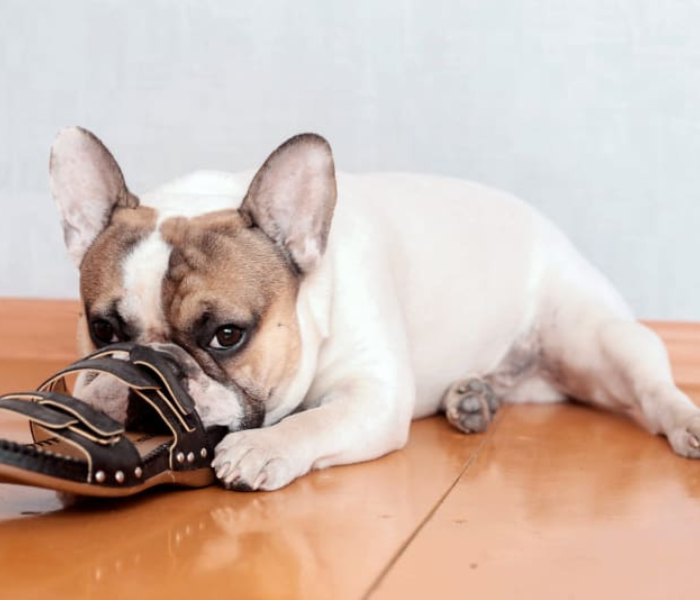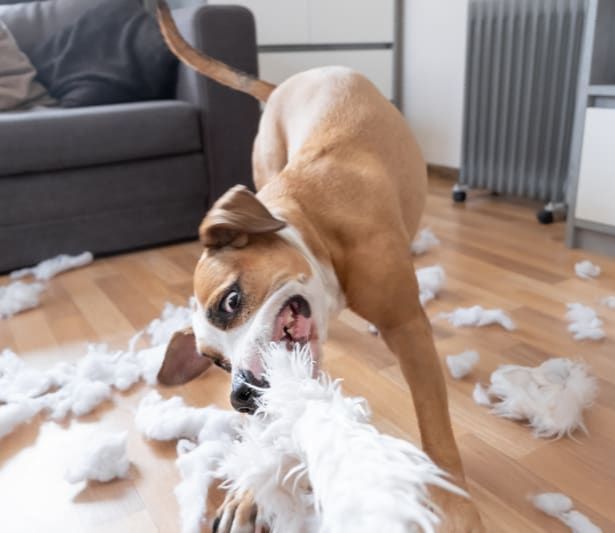A Dog Behaviorist’s Guide To Excessive Chewing
Why Dog’s Love To Chew
Dogs chew for various reasons, including teething, boredom, anxiety, or simply exploring their environment. Chewing is a natural and healthy behavior for dogs, even our domesticated pets. It's a way for them to satisfy their instinctive needs and maintain good oral health. Canines are natural-born hunters, equipped with powerful jaws and sharp teeth to subdue and consume their prey. Their canine teeth, or fangs, are designed to puncture and immobilize, while their incisors tear and shred. The molars, located at the back of the mouth, are used for grinding and crushing.
Chewing on bones is a natural dental hygiene practice for dogs. The act of grinding and gnawing helps remove tartar buildup, while the tearing and shredding action aids in flossing, promoting healthy gums. The physical exertion involved in chewing strengthens the jaw, neck, and forelimb muscles.
To understand why your dog is chewing, consider a few factors. Teething puppies instinctively chew on objects to relieve the discomfort of emerging teeth. If your dog exhibits signs of distress when left alone, such as whining, barking, or accidents, separation anxiety may be the culprit. Boredom can also lead to destructive chewing, especially if your dog lacks sufficient mental and physical stimulation. Hunger can be another factor, particularly if your dog is on a restricted diet or not receiving enough food. They may target food-related items like bags or garbage.
Speak With A Dog
Training Expert
Speak With A Dog Training Expert
Thank you for contacting us!
We will contact you shortly!
Please try again later.
Teach Your Dog To Be A Good Housemate With Obedience Training
Dogs communicate with body language and sounds, and for many, their favorite way to vocally communicate is to bark. A bark or two is completely natural canine behavior, but excessive dog barking can be a serious problem. You won’t get any peace and quiet, your neighbors or landlord won’t appreciate it, and it could indicate your dog’s needs aren’t being met. But how do you stop your dog from barking?
To effectively manage barking, it's crucial to identify the underlying trigger. Boredom can lead to excessive barking, and providing mental and physical stimulation through toys, puzzles, and regular exercise can help alleviate this issue. On the other hand, separation anxiety may require a more comprehensive approach, such as gradual desensitization and behavior modification techniques. Sadly, because barking is so varied, there is no one-size-fits-all approach to stopping it.
A
bored dog needs something to do, and an
anxious dog needs to build confidence. If you identify why your dog is barking in a given situation, it will allow you to target your approach and deal with the barking more effectively.
Speak With A Dog
Training Expert
Speak With A Dog Training Expert
Thank you for contacting us!
We will contact you shortly!
Please try again later.
Certain breeds, like Shetland Sheepdogs, Border Collies, Boxers, and Labrador Retrievers, may have a higher tendency to chew due to their specific needs and personalities. Remember, chewing is a natural canine behavior that helps strengthen jaws, clean teeth, and alleviate boredom or anxiety. However, it becomes problematic when it leads to destructive behavior.


Chew On This: Tips For Controlling Your Dog’s Excessive Chewing
Coming home to a chewed-up pair of shoes is a frustrating experience for many dog owners. While it's a common behavior, especially in puppies, it can persist well into adulthood. Understanding the specific reason behind a dog's chewing behavior is crucial to effectively address it. By identifying the root cause, dog owners can implement appropriate strategies to redirect their pet's energy and protect their belongings. Hiring a dog behaviorist will allow your dog’s triggers to be identified and a behavior training program can be put into place.
Controlling your dog’s excessive chewing is often done in a multi-faceted approach. The following tips can temporarily help to minimize destructive chewing. First and foremost: dog-proofing your home is crucial. Remove tempting items, especially those with your scent, from your dog's reach. Confine your dog to a specific area when
Chew On This: Tips For Controlling Your Dog’s Excessive Chewing
Coming home to a chewed-up pair of shoes is a frustrating experience for many dog owners. While it's a common behavior, especially in puppies, it can persist well into adulthood. Understanding the specific reason behind a dog's chewing behavior is crucial to effectively address it. By identifying the root cause, dog owners can implement appropriate strategies to redirect their pet's energy and protect their belongings. Hiring a dog behaviorist will allow your dog’s triggers to be identified and a behavior training program can be put into place.
Controlling your dog’s excessive chewing is often done in a multi-faceted approach. The following tips can temporarily help to minimize destructive chewing. First and foremost: dog-proofing your home is crucial. Remove tempting items, especially those with your scent, from your dog's reach. Confine your dog to a specific area when unsupervised using baby gates or crates. Redirect their chewing to approved toys by gently guiding them away from inappropriate items and offering a suitable alternative. Providing a variety of durable chew toys, such as Nylabones, Kongs, or rubber toys, can keep your dog mentally and physically stimulated. Rotate these toys regularly to maintain interest.
To deter chewing on specific items, consider using bitter-tasting sprays, but monitor your dog's reaction as some dogs may not be deterred. Lastly, ensure your dog receives adequate physical and mental exercise. Daily walks, playtime, and training sessions can help alleviate boredom and reduce destructive behavior. By implementing these strategies, you can help curb your dog's chewing habits and protect your belongings.
Remember, destructive chewing is often a temporary phase that most dogs outgrow. While it can be frustrating, maintaining a calm approach and implementing positive training techniques can help redirect your dog's behavior. Prioritize playtime, provide safe and engaging chew toys, and reward good behavior while gently redirecting unwanted actions. By investing time and effort, you can create a harmonious environment for both you and your furry friend.
unsupervised using baby gates or crates. Redirect their chewing to approved toys by gently guiding them away from inappropriate items and offering a suitable alternative. Providing a variety of durable chew toys, such as Nylabones, Kongs, or rubber toys, can keep your dog mentally and physically stimulated. Rotate these toys regularly to maintain interest.
To deter chewing on specific items, consider using bitter-tasting sprays, but monitor your dog's reaction as some dogs may not be deterred. Lastly, ensure your dog receives adequate physical and mental exercise. Daily walks, playtime, and training sessions can help alleviate boredom and reduce destructive behavior. By implementing these strategies, you can help curb your dog's chewing habits and protect your belongings.
Remember, destructive chewing is often a temporary phase that most dogs outgrow. While it can be frustrating, maintaining a calm approach and implementing positive training techniques can help redirect your dog's behavior. Prioritize playtime, provide safe and engaging chew toys, and reward good behavior while gently redirecting unwanted actions. By investing time and effort, you can create a harmonious environment for both you and your furry friend.
